

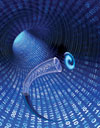
|
New Optical Fiber Puts a Twist on Data Transmission
New research by optical fiber experts at Boston University and optical communications systems experts at the University of Southern California created a new kind of optical fiber stable enough to transmit donut-shaped laser beams called optical vortices, also known as orbital angular momentum (OAM) beams. “For several decades since optical fibers were deployed, the conventional assumption has been that OAM-carrying beams are inherently unstable in fibers,” said BU engineering professor Siddharth Ramachandran, who designed the new fiber. “Our discovery of design classes in which they are stable has profound implications for a variety of scientific and technological fields that have exploited the unique properties of OAM-carrying light, including the use of such beams for enhancing data capacity in fibers.”
|
|
|
|

Trumpf Names New CEO
Dr. Lars Gruenert, previously executive vice president of Trumpf GmbH + Co. KG of Ditzingen, Germany, and CFO of the Laser Technology/Electronics div., has succeeded 25-year company veteran Rolf Biekert as president and CEO of Trumpf Inc., effective immediately, the industrial laser company announced this week.
|
|
|
|

Machine Vision Groups to Cooperate on Market Research
The European Machine Vision Association and the Automated Imaging Association, North America’s machine vision trade group, have agreed to cooperate on market research by providing data-compatible quarterly reports.
|
|
|
|


|
|
 |

|
LED Measurement Tester
Gigahertz-Optik
The BTS256-LED Tester manufactured by Gigahertz-Optik Inc. measures the luminous flux, color and spectral characteristics of printed circuit board-mounted LEDs, discrete LEDs within a module, miniature lamps, endoscopes and any narrow beam-emitting light source.
More info >>
|
|
 |

|
Mini and Micro Lens Elements
Argyle International, Inc.
Argyle International has added a new series of miniature and micro lens elements to its diverse line of custom optics. Lens designs range from single and double convex, single and double concave, meniscus, rod lenses, and rod doublets and triplets. Sizes down to 0.8mm.
More info >>
|
|
 |
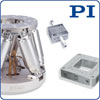
|
Mini Hexapod 6-Axis Positioner
PI (Physik Instrumente) L.P.
PI is the global leader in hexapod precision positioning platforms and controllers. The H-811 Hexapod is a compact new 6-axis motion control system available for both ambient and vacuum environments.
More info >>
|
|
 |



First Bonenfant Memorial Scholarship Awarded
The $8000 OSA Foundation scholarship that honors late optical communications expert Paul A. Bonenfant was awarded to Stephanie Laga, a senior at the California Institute of Technology.
|
|
|
|

New Photodetector Makes Do with Few Photons
Using a scheme based on quantum mechanics called unambiguous state discrimination, the lowest error rate yet was achieved for a photodetector deciphering a four-fold phase encoding of information. The photodetection system was demonstrated at the Joint Quantum Institute in Maryland.
|
|
|
|

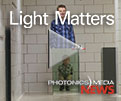
|
On this edition of the industry's only weekly newscast: a new optical fiber puts a twist on data transmission, a telescopic contact lens helps the visually impaired see, fluorescent fingerprinting aims to increase IDs from hidden prints on bullets and knives, and a father and his sons devise a simple way to explain optical cloaking. Hosted by Photonics Media's Melinda Rose and Laura Marshall.
|
|
|

Labsphere Promotes Rivera
Victoria Rivera, Labsphere's global account manager for OEM products and Western US sales manager since 2009, will now manage global sales and accounts for the company’s light measurement, uniform light source, and reflectance material and coating products.
|
|
|
|

Telescopic Contact Lens Helps AMD Patients See
A slim, telescopic contact lens that switches between normal and magnified vision using liquid crystal eyeglasses could provide a relatively unobtrusive way to enhance the sight of patients with age-related macular degeneration, say researchers at UCSD and in Switzerland.
|
|
|
|

Solar Cells Get Skinny
Most efforts to improve photovoltaics today have focused on increasing energy conversion efficiency or lowering manufacturing costs, but what would happen if the size of the cell were shrunk? Engineers at MIT are using computer modeling to help answer that question.
|
|
|
|

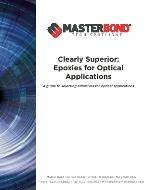
|
Clearly Superior Epoxies for Optical Applications
Master Bond Inc.
As technology in the optics industry continues to advance and improve, careful consideration of the properties of epoxies must be evaluated. When determining the most effective adhesive to be used in opto-electronics, medical and other optic related industry applications, trade-offs of key characteristics should be assessed. Here is a guide to the different properties to consider, their benefits and potential disadvantages and advice on how to prioritize these factors for the success of the application.
DOWNLOAD WHITE PAPER >>
|




|
SPIE Optics + Photonics is the largest interdisciplinary technical conference in North America, presenting the latest research and technologies in solar, nano, optics, photonics and space optics. The conference’s four symposia (Nanoscience + Engineering, Solar Energy + Technology, Organic Photonics + Electronics, and Optical Engineering + Applications) will offer more than 3200 presentations, including plenary and featured talks on topics such as metamaterials for molded optical wavefronts, asteroid-tracking and collision-mitigation, Kepler’s search for Earthlike planets and nanoparticle technology to convert solar energy directly into saturated steam for sterilizing tools and waste. The show also will include more than 40 professional development courses, poster sessions, panel discussions and a tribute to H. John Caulfield.
MORE INFO >>
|
|
|

|


Follow Photonics Media on Facebook and Twitter
|
 

|
|

FEATURED VIDEO
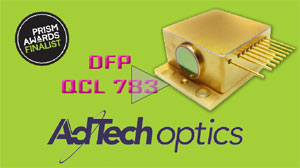
AdTech Optics - DFB Quantum Cascade Laser
The DFB QCL 783 is a single-mode, high-power quantum cascade laser at 7.83 µm for high-sensitivity detection of critical greenhouse gases. The laser is capable of 280-mW continuous output power at room temperature in a single mode and with an excellent beam quality, at a wavelength previously unattainable with a semiconductor device. It allows parts-per-billion-level detection of methane and nitrous oxide for applications such as pollution monitoring and emissions control, among others.
|
|
|

sponsor
 |


sponsor
.jpg) |

sponsor
 |



|